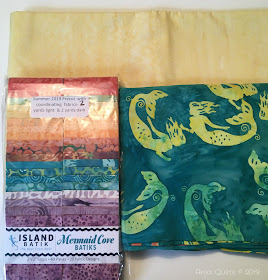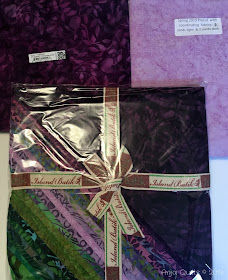Are you ready to put the binding on your
Broken Panes Quilt Along quilt? I'm going to share how I bind my quilts by machine. The Broken Panes pattern is available from Jen @
Patterns by Jen.
There are many ways to do binding, whether you hand sew to the back or machine sew both sides. This is a technique I have perfected for myself based on various tutorials and information from other quilters. There is a lot of information on the internet if you want to take a look around if my technique does not work for you.
After you have trimmed your quilt, prepare your binding strips in your usual fashion. I like to use 2.5-inch strips as I like the look of it and because I can use leftover pieces in other projects or bindings.
I like to start around the middle of one side of the back of the quilt. You need to leave a tail of about 6 to 8 inches before you begin sewing. In the photo below, I would start sewing at the pin.
I like to sew with a 3/8-inch seam allowance using my walking foot. You can sew with a 1/4-inch seam allowance -- it's all personal preference. I find this give me a snug binding -- the binding is against the edge of the quilt with no gap.
I will use one pin to hold the binding in place. I'll lay the binding in place and put a pin about 6 to 8 inches ahead of my sewing. I'll sew to the pin, remove it, and then adjust the binding in place and re-pin to continue sewing.
When you get to the end, you need to stop before the edge the same distance as your seam allowance. If you use a 3/8-inch seam allowance, you need to stop 3/8-inch before the edge. I have discovered an easy techinique without having to measure. You need to crease your binding on a 45-degree angle. For most fabrics, you can just finger press. For this photo, I used a ruler and my hera marker. I often use my hera marker if I can't see a finger crease.
To get the 45-degree crease, you fold the binding to your right, aligning the bottom edge of the binding with the edge of the quilt.
You should stop sewing just before your reach the crease -- do not sew into the crease. This will allow you to get a better mitered corner. I usually do a quick back stitch before cutting the threads.
People often forget how to make a 45-degree angle and how to turn for the next side of the quilt. I always say: make an L in order to go Left. You'll see the binding makes an L shape.
To start the next side, you fold the binding to the left, aligning the fold along the edge of the quilt that you just sewed the binding to. I like to put a pin to hold in place. Beginning at the top edge of this new side, continue sewing the binding until you reach the next corner. Follow the steps above to miter your corner.
Once you sew the fourth corner, you'll be back on the side that you started with. I normally stop sewing about 10 to 12 inches before I reach the beginning of the binding.
The key to joining to the two ends is to use the measurement of the width of your binding strips. So if you cut your binding strips at 2.5 inches, then the overlap is 2.5 inches. If you cut your binding at 2.25 inches, then your overlap is 2.25 inches. This is another reason why I cut my binding at 2.5 inches all the time -- easier math.
There are different ways for you to measure, but I like to use my 1 x 6 inch ruler. I make sure the first end of the binding is lying flat and then I abut the ruler next to it.
I then place the end of the binding (the part that I just finished sewing down) alongside the quilt and pin in place just before my ruler. You can get all fancy and mark the 2.5-inch overlap, but I'm too lazy, so I just eyeball it.
One trick is to actually make your cut 1/8-inch less than your overlap. So technically, I should be cutting at 2.5 inches; however, I will cut at 2 3/8 inches -- one 1/8 inch less. The reason for this is sometimes if your sewing is not precise, you could end up with a bit more binding than fits the quilt. I find the 1/8 inch less allows the binding to fit perfectly. And by chance, you end up with a tiny bit less binding than you need, it's easy to pull it in place. If you have too much binding, you'll end up with a bulge.
So now you have two ends that need to be sewn together so you can finish the binding. You need to open up the binding piece on the left (the piece you started sewing with). Open up the second binding piece but you need to flip it up and twist in order for it to be right sides together with the other end.
You'll see in the picture below how the loop goes once you've flipped it. It's important that your flip in the right direction. Sew the ends together on the diagonal like you would normally join binding ends. I don't normally mark my sewing line, but if you need a visual guide, the line is helpful.
I open up the binding strip before cutting the excess to make sure I sewed correctly.
And I lay the strip on the quilt to make sure it fits. If you have too much or too little binding, you can re-sew the seam. Which is possible because you have not yet cut the ends.
Trim the ends and then continue sewing the binding in place until you reach where you started at the beginning.
I will then iron the binding from the back. This will help you fold over the binding to the front and give you a better fit.
Depending on my mood and the size of my project, I will often iron the binding down to the front. But I will always iron the corners and clip them in place. This will help give you a better mitered corner.
Start sewing (to the front). You want the fold of the binding to just lie on top of the stitch line (from sewing to the binding to the back). And you want to sew as close to the fold as you can. But doing this, you'll be sewing right into the stitch line.
You'll see below that the stitching is right on the edge of the fold without sewing off into the binding.
This is what it looks like from the back.
Now I'm not a perfect sewer, and sometimes I don't always hit in the right place. I could have not folded the binding into the right spot on the front. I could sewed a little off on the front. But in any event, I find the little "errors" that I make are fine. You'll see below that you can often see stitches in the actual binding. But if you use a matching thread, it's not very noticeable.
I sometimes will end up with stitches on the quilt. Again, not very noticeable. I'm okay with this less than perfect sewing because it saves me time doing it all by machine. If I had to hand sew my bindings to the back, I'd never have any finishes.
I hope you have found this tutorial helpful and that you'll give machine binding a try. There are many variations, but you need to find what works for you. For example, I've seen some tutorials where they glue down the binding to the front to assist with sewing.
Stay tuned to see my finished Broken Panes quilt in the coming weeks.























































